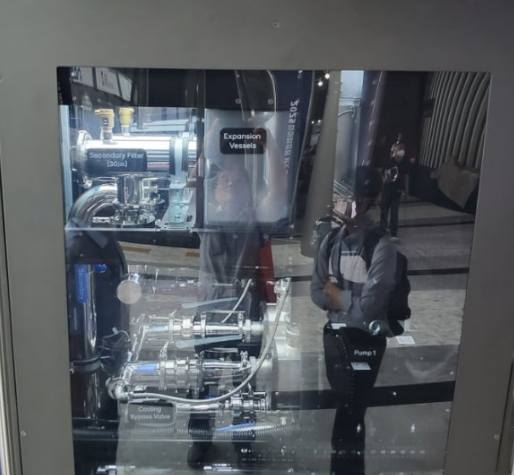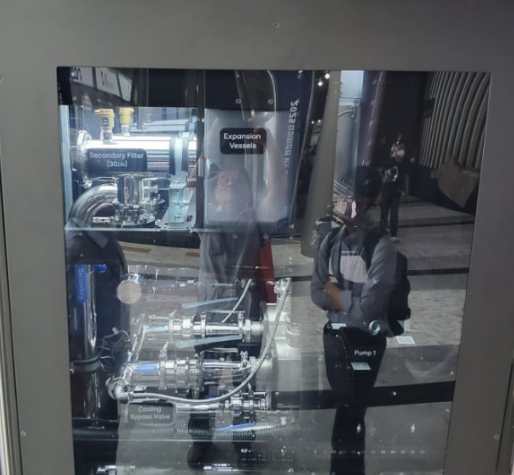CDU Solution of 10 Racks in Data Center
CDU Solution of 10 Racks in Data Center
What is a CDU?
A Coolant Distribution Unit (CDU), also known as a Coolant/Cooling Distribution Unit, is a specialized device in a liquid cooling system that:
-
Manages coolant temperature and flow: It precisely controls the temperature and flow rate of the liquid coolant (typically water or a water/glycol mixture, or even dielectric fluids) delivered to IT equipment.
-
Isolates IT equipment from facility water: It creates a secondary, closed-loop system for the IT equipment, separating it from the primary facility chilled water loop. This is crucial for maintaining the purity and specific temperature/pressure requirements of the coolant circulating through sensitive IT hardware.
-
Transfers heat: It acts as a heat exchanger, transferring heat from the IT equipment's liquid cooling loop to the facility's primary cooling system (e.g., chillers, cooling towers).
-
Monitors and controls: CDUs are equipped with sensors to monitor coolant parameters like temperature, flow rate, and pressure. They often have intelligent controls to adjust these parameters in real-time based on the IT load, ensuring optimal cooling efficiency and preventing issues like condensation.
CDU Solution for 10 Racks: Key Considerations
For a 10-rack data center, the CDU solution would typically involve a combination of the following:
-
CDU Sizing and Capacity:
-
Heat Load Assessment: The most crucial step is to accurately determine the total heat load (in kW) generated by all servers and networking equipment across the 10 racks. This will dictate the required cooling capacity of the CDU. Modern racks can generate anywhere from 10 kW to over 100 kW per rack, so a 10-rack setup could range from 100 kW to 1 MW or more.
-
Scalability: Consider future expansion. Even if current racks have a lower density, future hardware upgrades (e.g., next-gen AI accelerators) could significantly increase heat output. Choose a CDU solution that can be scaled or easily integrated with additional units.
-
Redundancy (N+1 or 2N): For mission-critical data centers, N+1 redundancy (one extra CDU unit or critical components) is often implemented to ensure continuous cooling even if a component fails.
-
-
Type of CDU Deployment:
-
Row-Based CDUs: These are typically larger units placed at the end of a row or between rows of racks. They cool multiple racks in a concentrated area. For 10 racks, one or two powerful row-based CDUs might be sufficient, depending on the heat density per rack.
-
In-Rack CDUs: These are smaller units installed directly within the server rack. They provide highly localized cooling to the equipment within that specific rack. While they offer precise cooling, deploying 10 in-rack CDUs might be less efficient or more complex to manage than a centralized row-based solution for a cluster of 10 racks. However, for extremely high-density individual racks, they can be ideal.
-
Hybrid Solutions: Combining liquid cooling for high-density racks (via direct-to-chip or rear-door heat exchangers) and traditional air cooling for lower-density racks or the remaining data center space. CDUs are essential for managing the liquid loops in these hybrid setups.
-
-
Liquid Cooling Technology Integration:
-
Direct-to-Chip Cooling: Coolant is directly delivered to cold plates mounted on high-heat components like CPUs, GPUs, and memory. This is highly efficient and common for AI/HPC workloads. The CDU would supply and return the coolant for these cold plates.
-
Rear Door Heat Exchangers (RDHx): Liquid-cooled heat exchangers replace the rear doors of server racks. Hot air from the servers passes through the heat exchanger, transferring heat to the liquid coolant, which then flows back to the CDU. This is a common solution for moderate to high-density racks (up to 40-60 kW/rack).
-
Immersion Cooling: While less common for only 10 racks due to infrastructure requirements, for extremely high densities (100+ kW/rack), servers are fully submerged in a dielectric fluid. CDUs play a role in managing the fluid's temperature and flow in such systems.
-
-
Connectivity and Infrastructure:
-
Piping Network: A robust piping infrastructure (typically stainless steel or specialized plastics) is needed to distribute the coolant from the CDU to the racks (cold plates or RDHx) and return the heated coolant.
-
Facility Water Connection: The CDU will require a connection to the data center's main chilled water loop or other primary cooling source (e.g., dry coolers on the roof).
-
Power and Control: CDUs require electrical power and network connectivity for monitoring and control integration with the data center's Building Management System (BMS) or Data Center Infrastructure Management (DCIM) software.
-
-
Safety and Reliability Features:
-
Leak Detection: Advanced CDUs include sophisticated leak detection systems to quickly identify and alert operators of any coolant leaks, minimizing potential damage to IT equipment.
-
Redundant Pumps and Filtration: Many CDUs feature redundant pumps to ensure continuous coolant flow even if one pump fails. Integrated filtration systems maintain coolant quality and extend component lifespan.
-
Automated Controls: Intelligent controls that can automatically adjust flow rates, temperatures, and pressures based on IT load fluctuations, and provide alerts for abnormal conditions.
-
Couldn't load pickup availability
Low stock: 1 left
View full details
